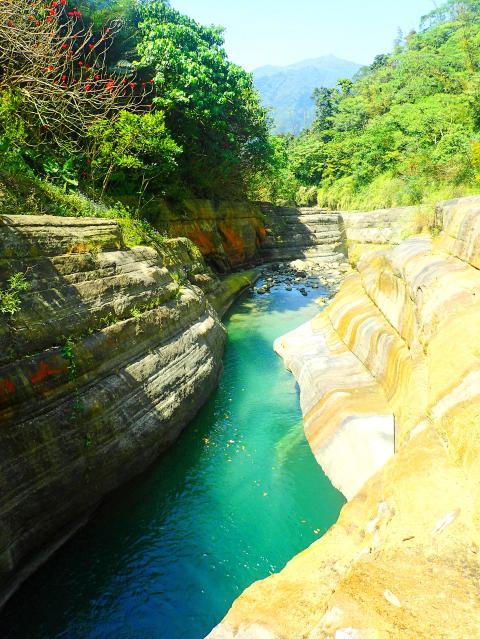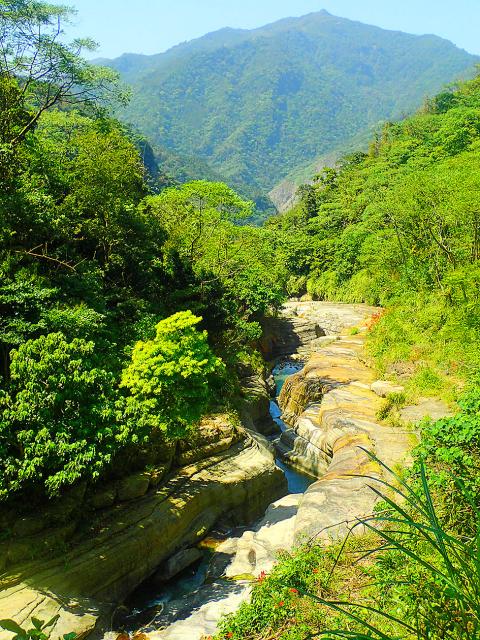Most people would probably agree that Taroko Gorge is Taiwan’s greatest tourist attraction, yet as I contemplate yet another visit (it’s naturally one of the essential elements of any tour when friends or relatives come), I’m likely to moan a little.
Anticipating convoys of tour buses, the lack of any really good permit-free hikes in the gorge, and an atrocious jabsence of edible food among the stalls at Tiansiang (天祥) doesn’t have me itching to return.
However, once there, and passing, awestruck, through its narrowest, most spectacular sections, goggling up at the towering walls hemmed in so close together, it’s hard to disagree that this is the most incredible thing most visitors to Taiwan will ever see.

Photo: Richard Saunders
GORGES, GORGES EVERYWHERE
Taiwan actually boasts other gorges and canyons that, in their way, are almost equally spectacular. Nantou County’s legendary but presently inaccessible Taiji Canyon (太極峽谷) springs immediately to mind, and some of the great chasms cut by countless streams and rivers in the remote central highlands are truly spectacular, yet have been barely explored.
However, size isn’t the only consideration, and no place in Taiwan fits the adage that small is beautiful better than Wannian Gorge (萬年峽谷) in central-southern Yunlin County. For several hundred meters a large mountain stream here has cut into an expanse of flat bedrock to create a small but stunning gorge.

Photo: Richard Saunders
The stream plunges over a series of little waterfalls and waterslides and through a chain of deep pools before finally plummeting over the much bigger drop of Dragon Phoenix Waterfall (龍鳳瀑布) at the end. Above the gorge, the stream can be traced up to the foot of another lofty and rarely visited cascade, Tongxin Waterfall (同心瀑布).
Getting to either waterfall unfortunately requires river tracing skills, but for less ambitious visitors, Wannian Gorge itself (the name means “10,000 years,” although it was surely created over a much longer period of time) is certainly fascinating and beautiful enough to warrant the protracted journey out there.
It’s also suitable for all: the (unintentionally) amusing English translation that appears on some signs — “All Ages Canyon” — is (for once) appropriate, as the short walk on a surfaced path down to the gorge is within the range of most people.

Photo: Richard Saunders
Sadly, there’s a catch.
Freely accessible for decades, since late last year access has officially been limited to the viewing platform above the gorge. Following a series of drowning deaths in the gorge’s deep pools over the last couple of years, local authorities have recently clamped down hard, barricading (with an ugly expanse of metal sheeting) the trail that leads the last few meters across the rock to the edge of the gorge.
According to a report I’ve heard, guards are also stationed here on weekends to make sure no one tries to sneak through and get down to the gorge and pools, although the place was deserted on my midweek visit in late last month.
Getting to Wannian Gorge means a fairly lengthy trip along winding mountain roads whichever direction you approach from. The nearest big town, Jhushan Township (竹山) in Nantou County, is a 30km drive away. From Chiayi City, which is better for scooter and car hire, it’s nearly 50km.
Take County Road 149B (149乙), the road running south from Jhushan to the mountain resort of Caoling (草嶺), and the way to the gorge is clearly signposted (in English). The last 3.5km are along the now dead-end route County Road 149A (149甲). Immediately after passing through the third half-tunnel turn sharp left to reach a car park at the start of the short trail down to the gorge.
TRAILHEAD
The trailhead is marked by a huge, inscribed boulder beside the track, and a family of free-range chickens always seem to be scurrying around. On my first visit a decade ago, I was astonished, as I passed through, to see the birds weren’t pecking around on the ground, as chickens usually do, but were all perched high up in the branches of the small trees that grow on either side of the lane. Whether they’d somehow evolved a talent to get themselves up there, or had been placed up there by a cunning human in an effort to stop them from wandering off, is one of those uniquely Taiwan mysteries that will probably never be solved.
Leaving the car park and chickens, the lane narrows to a surfaced path that zigzags gently down the hillside towards the gorge. In just a couple of minutes the finest section of Wannian Gorge comes into view. Here the Neihu Stream (內湖溪) has cut a narrow slot 10 to 15 meters deep through the flat, bare bedrock, exposing many layers of strata and creating a series of deep pools linked with cascades. About halfway down, a large, elongated pool (reputedly 10 meters deep) has been dubbed the Treasure Island Pool (寶島池), a reference, of course, to Taiwan, due to its shape.
Some of the pools look perfect for a swim, especially those near the bottom of the series, where the stream emerges from its narrow slot and runs over the wide and flat, fossil-studded rock pavement, although swimming is no longer officially allowed.
Following the stream down for another 100 meters, the water begins cutting deep into the flat rock bed once more, before it makes a curious and very sudden 90-degree bend, and plummets off a sheer, 20-meter-high cliff in the spectacular Dragon Phoenix Waterfall (龍鳳瀑布).
Gingerly peering over the edge, only a glimpse of the torrent can be seen. To see the waterfall properly means another lengthy, slow drive along winding mountain roads to Jhanghu (章湖), and a 30-minute river trace.
Richard Saunders is a classical pianist and writer who has lived in Taiwan since 1993. He’s the founder of a local hiking group, Taipei Hikers, and is the author of six books about Taiwan, including Taiwan 101 and Taipei Escapes. Visit his Web site at www.taiwanoffthebeatentrack.com

On April 26, The Lancet published a letter from two doctors at Taichung-based China Medical University Hospital (CMUH) warning that “Taiwan’s Health Care System is on the Brink of Collapse.” The authors said that “Years of policy inaction and mismanagement of resources have led to the National Health Insurance system operating under unsustainable conditions.” The pushback was immediate. Errors in the paper were quickly identified and publicized, to discredit the authors (the hospital apologized). CNA reported that CMUH said the letter described Taiwan in 2021 as having 62 nurses per 10,000 people, when the correct number was 78 nurses per 10,000

As we live longer, our risk of cognitive impairment is increasing. How can we delay the onset of symptoms? Do we have to give up every indulgence or can small changes make a difference? We asked neurologists for tips on how to keep our brains healthy for life. TAKE CARE OF YOUR HEALTH “All of the sensible things that apply to bodily health apply to brain health,” says Suzanne O’Sullivan, a consultant in neurology at the National Hospital for Neurology and Neurosurgery in London, and the author of The Age of Diagnosis. “When you’re 20, you can get away with absolute

May 5 to May 11 What started out as friction between Taiwanese students at Taichung First High School and a Japanese head cook escalated dramatically over the first two weeks of May 1927. It began on April 30 when the cook’s wife knew that lotus starch used in that night’s dinner had rat feces in it, but failed to inform staff until the meal was already prepared. The students believed that her silence was intentional, and filed a complaint. The school’s Japanese administrators sided with the cook’s family, dismissing the students as troublemakers and clamping down on their freedoms — with

As Donald Trump’s executive order in March led to the shuttering of Voice of America (VOA) — the global broadcaster whose roots date back to the fight against Nazi propaganda — he quickly attracted support from figures not used to aligning themselves with any US administration. Trump had ordered the US Agency for Global Media, the federal agency that funds VOA and other groups promoting independent journalism overseas, to be “eliminated to the maximum extent consistent with applicable law.” The decision suddenly halted programming in 49 languages to more than 425 million people. In Moscow, Margarita Simonyan, the hardline editor-in-chief of the